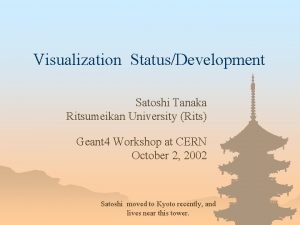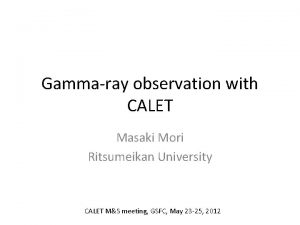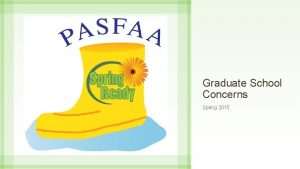Ritsumeikan University Graduate School of Science and Engineering



















- Slides: 19

Ritsumeikan University Graduate School of Science and Engineering Advanced Architectural, Environmental and Civil Engineering Master Thesis Defense Presenter: Fayezurahman Azizi ID : 6141130021 -7 Academic advisor: Prof. Satofuka Yoshifumi Civil Engineering Department Watershed Design Laboratory Date: 2015. 08. 05 Panj‐e‐Amu Basin in the Upper Panj area (Panj River)

Thesis Structure Chapter 1. Introduction Chapter 5. Flood Runoff Analysis Chapter 2. Literature Review Chapter 6. Hydrological Analysis for Water Availability Chapter 3. Study area and Dataset Chapter 4. Approach and Methodology Chapter 7. Conclusions and Recommendation

Introduction overview v Afghanistan is divided to five major basin ü Over 80% percent of the population relies directly on the natural resources of the River basins. ü Provides the Upstream water of four major river basin that flow into neighboring countries ü The restructuring of river basins was started in 2011 v. The IWRM concept in the river basins is to promote a decentralization of water resource management and water planning into river basin‐level and sub‐basin level management.

Problems and issues v Lack of Water Resources planning throughout the River Basin ü ü Environmental degradation Extreme flood disaster and erosion problems The lack of historical data Demand for water needs has dramatically increased Dashti‐Qala Darqad O A Darqad E Hairatan Kaldar D The most Vulnerable cities along Amu River Darqad Kokcha River Dashti‐Qala Sheberghan Balkh Samangan Kunduz River Taloqan River Takhar

Objectives The purpose of this study is how to analyze flood runoff and evaluate water availability based on the hydrological process using the IFAS and WEAP models , to utilize its result as a step for integrated river basin management planning and dams’ feasibility. The specific objectives are: • Calculating rainfall‐runoff for flood runoff analysis and estimate flood probability • Compare the correlation of GSMAP‐NRT estimated rainfall and river discharge data by IFAS with ground based data. • Calculating the annual average rainfall loss , effective rainfall and water loss • Estimate the supply ability of the basin to its future water demands • Assess the direct runoff coefficient of river regime flow , water availability and basin characteristics

Study Area Ø This Basin accounts for about 57% percent of the annual water discharge of the country Ø Estimated irrigation area total is about 424, 000 ha

Dataset and characteristics of The Panj-e-Amu River Basin ØThe 32 Hydrological stations data are still available Location of the Stations Ø The annual average precipitation is about 400 mm (2009‐ 2013) Ø annual average temperature is about 13. 6 C (2009‐ 2012) ü Max (43. 2 C◦) Lower Kunduz basin ü Min (‐ 32. 7 C◦) Upper Panj basin Ø The terrain (DEM) of the Basin ranges from 200 m to 7470 m New Hydrological Stations New Stations at the same location of old H. ST Existing Dam Ø Two Irrigation and hydropower dam Ø Bare Rock with loamy very fine sand is covered the most part of the basin while Silt Loam is the second and Rock with Loamy Very Fine Sand is the third

Approach and Methodology For the Watershed Design sustainability, development of integrated management planning aspects, must be considered. ØBe able to analyze and control flood disaster to reduce the economic damages ØBe able to allocate water balance of the basin for prospective planning ØBe able to assess the river basin characteristics and ability The Following Approaches and methodology used in this study WEAP Model Water Evaluation and planning Water Allocation Data collection /Handling Hydrological Process /water Availability, Rainfall losses Supply Future Water Demands • • • Gumbel extremevalue distribution Flood Frequency analysis/Return periods, Probability exceedance Hydrological Data Meteorological Data Geological Data River basin Management planning IFAS Integrated Flood Analysis System Flood Runoff analysis

IFAS Processing Structure IFAS Processing structure Rainfall Data o Ground‐based rainfall data (WRD‐Stations) o satellite‐ based rainfall data ‐GSMAP‐NRT(JAXA) o Building channel network, Elevation and Land Use (GLCC-USGS) o Global Map (ISCGM) spatial resolution 30 sec Modeling o Importing Target Runoff analysis Kokcha o Estimation and Modifies Water Tanks Parameter o PWRI‐Distributed Model Ver 2. 0 Display of results Flow of surface Tables & Graphs IFAS is an Integrated Flood Analysis System, calculates river discharge based on GIS data. ü Entire World Rainfall Data are Available ü IFAS goal is oriented to the developing countries which is lack of hydro meteorological data.

Processing Structure WEAP is an unique approach for conducting integrated water resources planning assessments v Calculates water demand, supply, runoff, reservoir and power production under different hydrologic and policy scenarios v Evaluates a full range of water development and management options Start Schematic data of the basin Draw River Line Create Account years (2015‐ 2030) for calculation WEAP Processing Create Area (Kokcha Sub- Basin) Insert GIS Layer Demand Priority (Faizabad City , Agriculture) Connect Demand With Supply Connect return flow link Inter Monthly Average Flow Run the WEAP for calculation Make and Compared Scenarios References scenario (2015‐ 2030) Change Irrigation Rate Change Growth rate Pop (2. 4, 3, 5%) scenarios Reservoirs and Power Production calculations Kokcha (Modeling Reservoirs ) Charts Results of Calculations Hydropower Computation Tables Modeling Runoff‐River Power Plant Schematics

Results and Discussions ‐ Flood Runoff Analysis by IFAS Summary of Flood Limits (M 3/Sec) For The Panj-e-Amu River Basin, April, 2012 Based on GSMAP‐NRT Rainfall(mm) data No Station River 1 2 3 4 5 6 Khojaghar Faizabad Keshem Teshkan Anjuman Jurm Kokcha Keshem Teshkan munjan Jurm 7 8 Baharak Shashpul Shuhada Shashpul Low‐ Flood 419. 08 Base on Hourly Ground Rainfall(mm) Medium‐Flood High‐flood 599. 42 569. 35 Measurement Discharge Low‐ Flood 451 Medium‐Flood 682. 13 High‐flood Low‐ Discharge Medium‐Discharge High‐Discharge 1101. 19 102. 00 137. 5 190. 00 193. 58 287. 37 389. 82 245. 51 421. 49 666. 13 127 148. 2 169. 00 47. 59 67. 19 70. 20 57. 74 81. 82 126. 96 6 7. 5 9. 00 15. 81 24. 19 25. 58 18. 28 30. 23 48. 96 8. 8 8. 9 9. 1 7. 26 9. 59 10. 00 8. 15 12. 8 22. 82 1. 12 1. 32 2. 18 2. 57 2. 65 1. 86 3. 42 5. 29 23. 6 30. 9 33. 4 6. 40 8. 89 9. 30 19 32. 38 47. 59 9 10. 0 11 4. 34 6. 03 6. 35 21. 69 32 55. 83 24. 8 27. 1 30. 1 Khojaghar Kokcha Location of Hydrological Stations are used for calculation/IFAS Ø The IFAS by using the data of Satellite GSMAP‐NRT rainfall calculated the peak discharge of magnitude 599. 42 m 3/sec on 2012/04/15 at 24 hours. Ø While the IFAS by using the data of ground rainfall calculated the peak discharge of magnitude 1101 m 3/sec on 2012/04/29 at 24 hours.

Results and Discussions ‐ Flood Runoff Analysis Ø The IFAS showed high river course discharge with GSMAP‐NRT rainfall than measured data in most cases Flood Runoff_ Comparison at Khojaghar Hydrological Station 0 1400 800 600 400 200 0 10 20 30 Peak Discharge = 1106. 9 m 3/s Direct Runoff Coeficient = 0. 36 40 Rainfall [mm/day] 1000 Gsmap NRT-Rainfall Ground-Rainfall GSMAP-NRT Rainfall-Discharge Ground Hourly Rainfall-Discharge Ground-Daily Rainfall- Discharge Measured Discharge 4/1/2012 4/2/2012 4/3/2012 4/4/2012 4/5/2012 4/6/2012 4/7/2012 4/8/2012 4/9/2012 4/10/2012 4/11/2012 4/12/2012 4/13/2012 4/14/2012 4/15/2012 4/16/2012 4/17/2012 4/18/2012 4/19/2012 4/20/2012 4/21/2012 4/22/2012 4/23/2012 4/24/2012 4/25/2012 4/26/2012 4/27/2012 4/28/2012 4/29/2012 4/30/2012 Daily Discharge [m 3/s] 1200 Ø The base flow and peak discharge calculated based on Ground rainfall (Hourly and Daily) are shown the highest in each and every case Ø The discharge calculated by the Satellite GSMAP_NRT rainfall is well agreement with the measured discharge in some places 50 Ø The tendency and total amount values of rainfall based GSMAP‐NRT are smaller , but in case heavy rainfall event over 14‐ 25 mm/h, the tendency and amount of some points are near to each other’s Ø The correlation of satellite‐based rainfall and ground‐based rainfall is almost , 50%

Results (Cont) - Gumbel extreme-value distribution method Ø The Probable floods Hydrograph is prepared by using a recorded flood Peak for the interval of 1. 01 , 5000 years. Flood Discharge(m 3/s) Ø First graph Shows the probability of flood frequency period based on 1965‐ 1979 years data Pul-e-Chugha Hydrological Station 1400 1200 1000 800 600 400 Annual Observed Flood 200 Gumbel Distribution 0 1 Ø The calculation result shows for the 100 year a 4369 m 3/Sec maximum probable flood 10 7000 1000 2000 500 200 80 40 25 10 2 1. 01 6000 5000 Discharge (m 3/sec) Return Period (years) 4000 5000 1000 300 100 50 30 20 5 1. 5 3000 2000 1000 0 1 2 3 4 5 6 7 8 Days Estimated Flood Hydrograph at Khojaghar Hydrological station Ø The May 22, 1969 flood, which was observed 1550 m 3/Sec, as a maximum flood during the period of 1964‐ 2013,

Result (Cont) - Future water Demands and Resources Ø This Graph shows the estimated of the water supply for the future demands with a high population growth rate scenario in Faizabad City, which is increase the Shortages of water for the Irrigations land. Proposed Dam “Qala‐i‐Mamay” Proposed Dam “Shurabak” Faizabad city

Result (Cont) - Rainfall Loss with Effective Rainfall Rate & direct runoff coefficient analysis ü An average of about 32% rainfall losses are showing in this Basin 503. ü An average of approximately 50 % water loss ü showing an annual average of around 0. 53 mm effective rainfall and a total of about 14. 25 mm 467 313 136 257 12. 8 237 379 294 473 144 268 165 202 30 28 54 Ø shows a large different direct runoff coefficient because of very rare rainfall on peak discharge timing in the dry season 401 466 300.

Result (Cont) - Mean Annual Runoff & River Flow Regime analysis of Panj-e-Amu River Basin Ø The mean annual runoff capacity is estimated 40 BCM (Billion Cubic Meter) per year Mean Annual Runoff Of Panj-e-Amu River Basin (2005 -2013) Pu ü The Khojaghar data presented 77% while Faizabad covered about 82% 7000 6000 5000 4000 3000 2000 1000 0 l‐i ‐ C Pu hug l‐ h Pu i‐ B a l‐i ang ‐ A i C lc Pu har hin l‐ D Ta i‐ M ara qc as h t Ne a K an ar ha T na a Kh loqa oj n ag h Ta Ge ar ng rd i N ab ah Ab Ba rin ov gh e la Ke n la ga Do i Pu l‐i Kh shi ‐ K e on nja d n Ah asa an ng ga Ba ran m Da ya sh te D n Pu ‐i‐ oab l ‐ Sa i‐ fe Te d sh Su kan m d Ne Ba ar har B ak ah a Ke rak Ne she ar m J Fa urm iza ba d Ta Kofa q b Ar Sh ch as a h Ne Anj Pul ar um K an es he m Mean Annual Runoff (Mm 3) Ø The spring/summer high‐water flow contributes around 79% of the total annual flow discharged into the Basin. Hydrological Stations Total Annual Runoff(BCM) River Flow Regime - Hydrograph 25% summer Parde-Coefficient (%) 20% 15% 10% Sprin Fall Winter 5% Faizabad 0% Jan Feb Mar Apr May Jun Khojaghar Jul Months/2012 Aug Sep 50 Panj-e-Amu River Basin -Total Annual Runoff 45 40 35 30 AWARD Oct Nov Dec World Bank New data/WRD

Conclusion • The Integrated Flood Analysis System model (IFAS) result was not satisfactory with measured and observed data in Panj‐e‐ Amu Basin. • The input data of Ground Surface‐Based rainfall could improve the flood runoff inflow of the IFAS simulation. • Flood peaks in the Panj‐e‐Amu River Basin is more influenced by snow melting while the air temperature is increasing during the summer in the mountainous area. • The Water balance method is more suitable in the estimation of Rainfall losses. • Panj‐e‐Amu River Basin has great ability for prospective and comprehensive planning.

Recommendations • More accurate adequate validation data of the basin and extension of Hydro meteorological networks in upstream are required for the Future sustainability and Planning. • For a comprehensive and sustainable watershed design in the future of Panj‐e‐Amu, the key association elements, including geological data, real demography , people life style, a more accurate assessment of land cover, land use , soil type , geo‐morphology development is required. • Its important to modify parameters of IFAS to be appropriate with the particular river basin.

Thanks For Your Attention ご清聴ありがとうございました
 Ritsumeikan asia pacific university notable alumni
Ritsumeikan asia pacific university notable alumni Oussep osaka
Oussep osaka Kupid korea university
Kupid korea university Usf graduate school
Usf graduate school Ajou university graduate school
Ajou university graduate school Erik jonsson school of engineering and computer science
Erik jonsson school of engineering and computer science The fu foundation school
The fu foundation school Erik jonsson school of engineering and computer science
Erik jonsson school of engineering and computer science Erik jonsson school of engineering and computer science
Erik jonsson school of engineering and computer science Graduate institute of electronics engineering
Graduate institute of electronics engineering Ntu
Ntu Graduate institute of electronics engineering
Graduate institute of electronics engineering Graduate institute of electronics engineering
Graduate institute of electronics engineering Graduate institute of electronics engineering
Graduate institute of electronics engineering Hamline graduate programs
Hamline graduate programs Psychology major towson
Psychology major towson What is her favourite subject?
What is her favourite subject? Aalto university school of engineering
Aalto university school of engineering University of belgrade school of electrical engineering
University of belgrade school of electrical engineering Glennan building cwru
Glennan building cwru




































